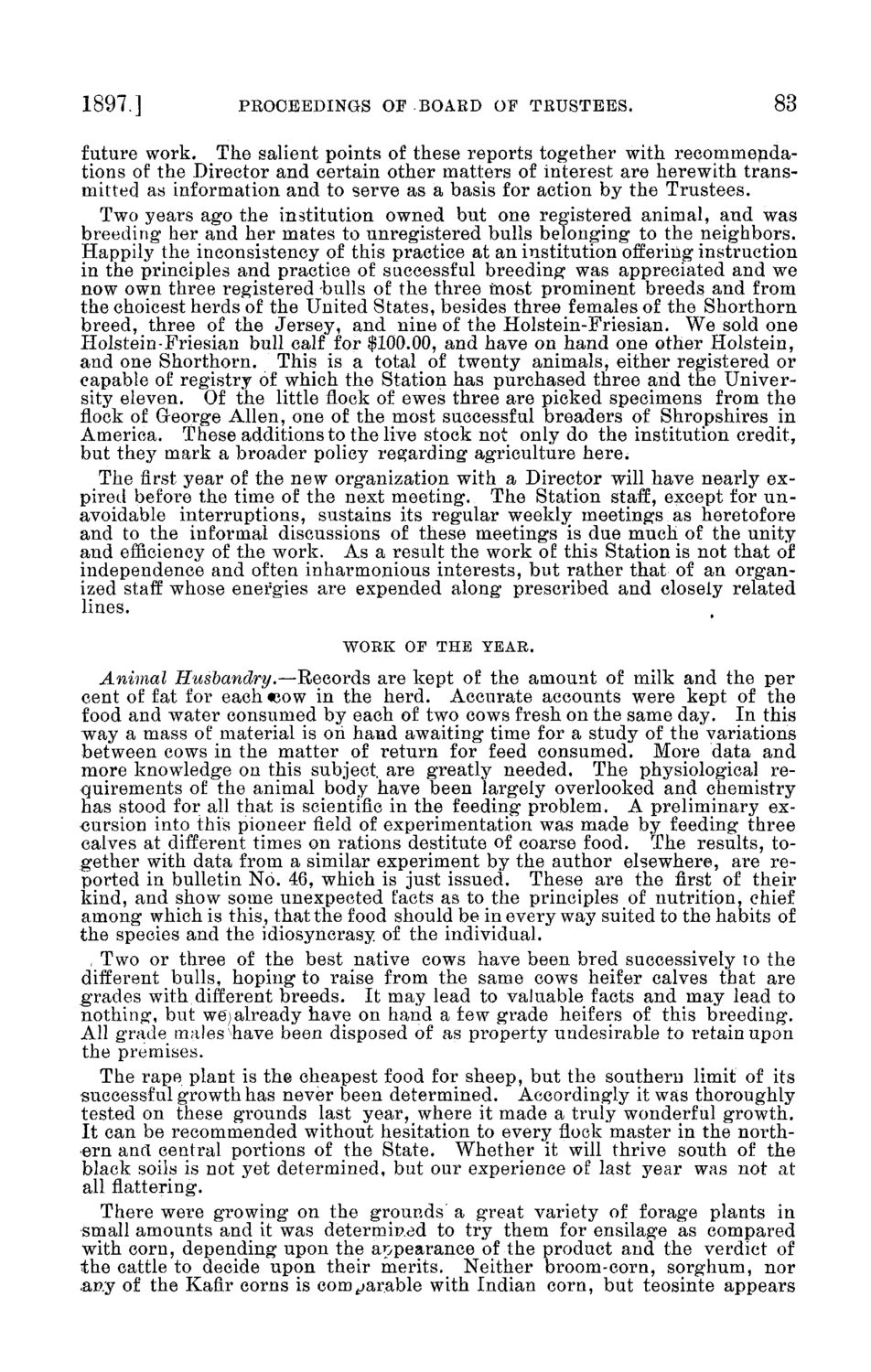| |
| |
Caption: Board of Trustees Minutes - 1898
This is a reduced-resolution page image for fast online browsing.

EXTRACTED TEXT FROM PAGE:
1897.] PROCEEDINGS OF -BOARD OF TRUSTEES. 83 future work. The salient points of these reports together with recommendations of the Director and certain other matters of interest are herewith transmitted as information and to serve as a basis for action by the Trustees. Two years ago the institution owned but one registered animal, and was breeding her and her mates to unregistered bulls belonging to the neighbors. Happily the inconsistency of this practice at an institution offering instruction in the principles and practice of successful breeding was appreciated and we now own three registered bulls of the three Most prominent breeds and from the choicest herds of the United States, besides three females of the Shorthorn breed, three of the Jersey, and nine of the Holstein-Friesian. We sold one Holstein-Friesian bull calf for $100.00, and have on hand one other Holstein, and one Shorthorn. This is a total of twenty animals, either registered or capable of registry of which the Station has purchased three and the University eleven. Of the little flock of ewes three are picked specimens from the flock of G-eorge Allen, one of the most successful breaders of Shropshires in America. These additions to the live stock not only do the institution credit, but they mark a broader policy regarding agriculture here. The first year of the new organization with a Director will have nearly expired before the time of the next meeting. The Station staff, except for unavoidable interruptions, sustains its regular weekly meetings as heretofore and to the informal discussions of these meetings is due much of the unity and efficiency of the work. As a result the work of this Station is not that of independence and often inharmonious interests, but rather that of an organized staff whose energies are expended along prescribed and closely related lines. WORK OF THE YEAR. Animal Husbandry.—Records are kept of the amount of milk and the per cent of fat for each «eow in the herd. Accurate accounts were kept of the food and water consumed by each of two cows fresh on the same day. In this way a mass of material is oh hand awaiting time for a study of the variations between cows in the matter of return for feed consumed. More data and more knowledge on this subject, are greatly needed. The physiological requirements of the animal body have been largely overlooked and chemistry has stood for all that is scientific in the feeding problem. A preliminary excursion into this pioneer field of experimentation was made by feeding three calves at different times on rations destitute of coarse food. The results, together with data from a similar experiment by the author elsewhere, are reported in bulletin No. 46, which is just issued. These are the first of their kind, and show some unexpected facts as to the principles of nutrition, chief among which is this, that the food should be in every way suited to the habits of the species and the idiosyncrasy of the individual. , Two or three of the best native cows have been bred successively to the different bulls, hoping to raise from the same cows heifer calves that are grades with different breeds. It may lead to valuable facts and may lead to nothing, but we)already have on hand a few grade heifers of this breeding. All grade males^have been disposed of as property undesirable to retain upon the premises. The rape plant is the cheapest food for sheep, but the southern limit of its successful growth has never been determined. Accordingly it was thoroughly tested on these grounds last year, where it made a truly wonderful growth. It can be recommended without hesitation to every flock master in the northern and central portions of the State. Whether it will thrive south of the black soils is not yet determined, but our experience of last year was not at all flattering. There were growing on the grounds a great variety of forage plants in small amounts and it was determined to try them for ensilage as compared with corn, depending upon the appearance of the product and the verdict of the cattle to decide upon their merits. Neither broom-corn, sorghum, nor any of the Kafir corns is comparable with Indian corn, but teosinte appears
| |